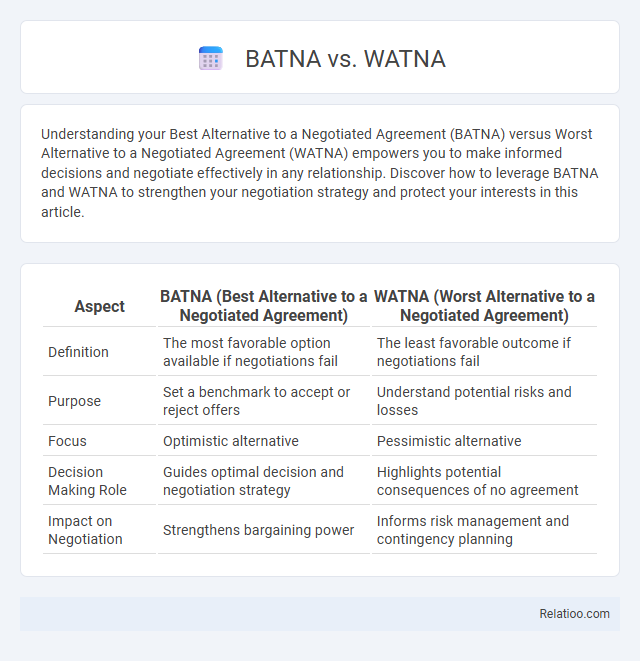Understanding your Best Alternative to a Negotiated Agreement (BATNA) versus Worst Alternative to a Negotiated Agreement (WATNA) empowers you to make informed decisions and negotiate effectively in any relationship. Discover how to leverage BATNA and WATNA to strengthen your negotiation strategy and protect your interests in this article.
Table of Comparison
| Aspect | BATNA (Best Alternative to a Negotiated Agreement) | WATNA (Worst Alternative to a Negotiated Agreement) |
|---|---|---|
| Definition | The most favorable option available if negotiations fail | The least favorable outcome if negotiations fail |
| Purpose | Set a benchmark to accept or reject offers | Understand potential risks and losses |
| Focus | Optimistic alternative | Pessimistic alternative |
| Decision Making Role | Guides optimal decision and negotiation strategy | Highlights potential consequences of no agreement |
| Impact on Negotiation | Strengthens bargaining power | Informs risk management and contingency planning |
Understanding BATNA and WATNA: Key Definitions
BATNA (Best Alternative to a Negotiated Agreement) represents the most favorable option a negotiator can pursue if negotiations fail, serving as a benchmark for decision-making. WATNA (Worst Alternative to a Negotiated Agreement) defines the least advantageous scenario a negotiator might face without a deal, highlighting potential risks and costs. Understanding BATNA and WATNA enables negotiators to evaluate their positions realistically and strategize effectively to maximize outcomes.
The Importance of BATNA in Negotiation
BATNA (Best Alternative to a Negotiated Agreement) is crucial in negotiations as it defines the most favorable course of action if no agreement is reached, empowering negotiators with a clear benchmark for evaluating offers. WATNA (Worst Alternative to a Negotiated Agreement) helps assess the risks of walking away, highlighting the stakes involved. Understanding your BATNA enables you to negotiate confidently, knowing when to accept a deal or pursue your alternative for the best outcome.
WATNA: Assessing Worst-Case Scenarios
WATNA (Worst Alternative to a Negotiated Agreement) identifies the most unfavorable outcome if negotiations fail, serving as a critical benchmark for risk assessment. Understanding WATNA helps negotiators prepare for the worst-case scenario, ensuring realistic expectations and informed decision-making. Accurate evaluation of WATNA enables negotiators to weigh the risks against potential benefits and develop strategies that minimize losses.
BATNA vs WATNA: Core Differences
BATNA (Best Alternative to a Negotiated Agreement) represents the most favorable outcome a negotiator can secure if current negotiations fail, while WATNA (Worst Alternative to a Negotiated Agreement) defines the least advantageous scenario a negotiator might face outside the negotiation. The key difference lies in BATNA highlighting the best fallback option and WATNA emphasizing the risk or downside, guiding negotiators in evaluating whether to accept a deal or pursue alternatives. Understanding BATNA and WATNA helps negotiators assess the balance of potential gains versus losses, shaping strategies for optimal agreement outcomes.
How to Identify Your BATNA
Identifying your BATNA begins with thoroughly understanding all available alternatives if negotiations fail, including specific options, resources, and outcomes outside the current deal. Evaluate and compare these alternatives based on their feasibility, value, and risk to determine the most advantageous fallback position. Knowing your BATNA empowers you as a negotiator to make informed decisions, set realistic goals, and avoid accepting unfavorable terms.
Evaluating Your WATNA Effectively
Evaluating your WATNA (Worst Alternative to a Negotiated Agreement) effectively requires a clear assessment of the most unfavorable outcome you might face if negotiations fail, which helps in comparing it against your BATNA (Best Alternative to a Negotiated Agreement). Skilled negotiators analyze potential risks, costs, and consequences to quantify the impact of the WATNA, ensuring informed decision-making during negotiation strategies. Understanding both WATNA and BATNA enables negotiators to create realistic expectations and strengthen their position by preparing for the worst while aiming for the best deal.
Strategic Advantages of Knowing BATNA
Understanding your BATNA (Best Alternative to a Negotiated Agreement) provides a critical strategic advantage by empowering you to gauge the minimum acceptable outcome during negotiations, thereby preventing unfavorable agreements. While WATNA (Worst Alternative to a Negotiated Agreement) highlights the potential risks of failing to reach a deal, the negotiator leverages BATNA to strengthen their bargaining position and make informed decisions confidently. Your ability to identify and improve your BATNA enhances negotiation leverage, ensuring more favorable terms and reducing the pressure to concede unnecessarily.
Risks of Overlooking WATNA in Negotiations
Overlooking your Worst Alternative to a Negotiated Agreement (WATNA) during negotiations exposes you to significant risks, including unanticipated losses and missed opportunities for risk mitigation. Unlike BATNA (Best Alternative to a Negotiated Agreement), which highlights your optimal fallback option, WATNA emphasizes potential negative outcomes if negotiations fail, ensuring you prepare for worst-case scenarios. A skilled negotiator balances awareness of both BATNA and WATNA to avoid costly surprises and maintain leverage in decision-making.
BATNA and WATNA in Real-World Negotiations
BATNA (Best Alternative to a Negotiated Agreement) represents the most favorable course of action if negotiations fail, providing negotiators with a clear benchmark to evaluate offers. WATNA (Worst Alternative to a Negotiated Agreement) defines the least advantageous outcome, helping negotiators understand potential risks and avoid unfavorable deals. Skilled negotiators leverage both BATNA and WATNA to balance opportunities and threats, optimize decision-making, and achieve strategic advantages in real-world negotiations.
Tips for Balancing BATNA and WATNA Strategies
Balancing BATNA (Best Alternative to a Negotiated Agreement) and WATNA (Worst Alternative to a Negotiated Agreement) strategies requires thorough assessment of potential outcomes to avoid biased decision-making. Negotiators should quantify both alternatives by analyzing the probable impact on goals, risks, and resources, enabling more informed and strategic choices during negotiations. Emphasizing objective evaluation and scenario planning helps negotiators maintain leverage while preparing contingency plans for unfavorable developments.

Infographic: BATNA vs WATNA
 relatioo.com
relatioo.com